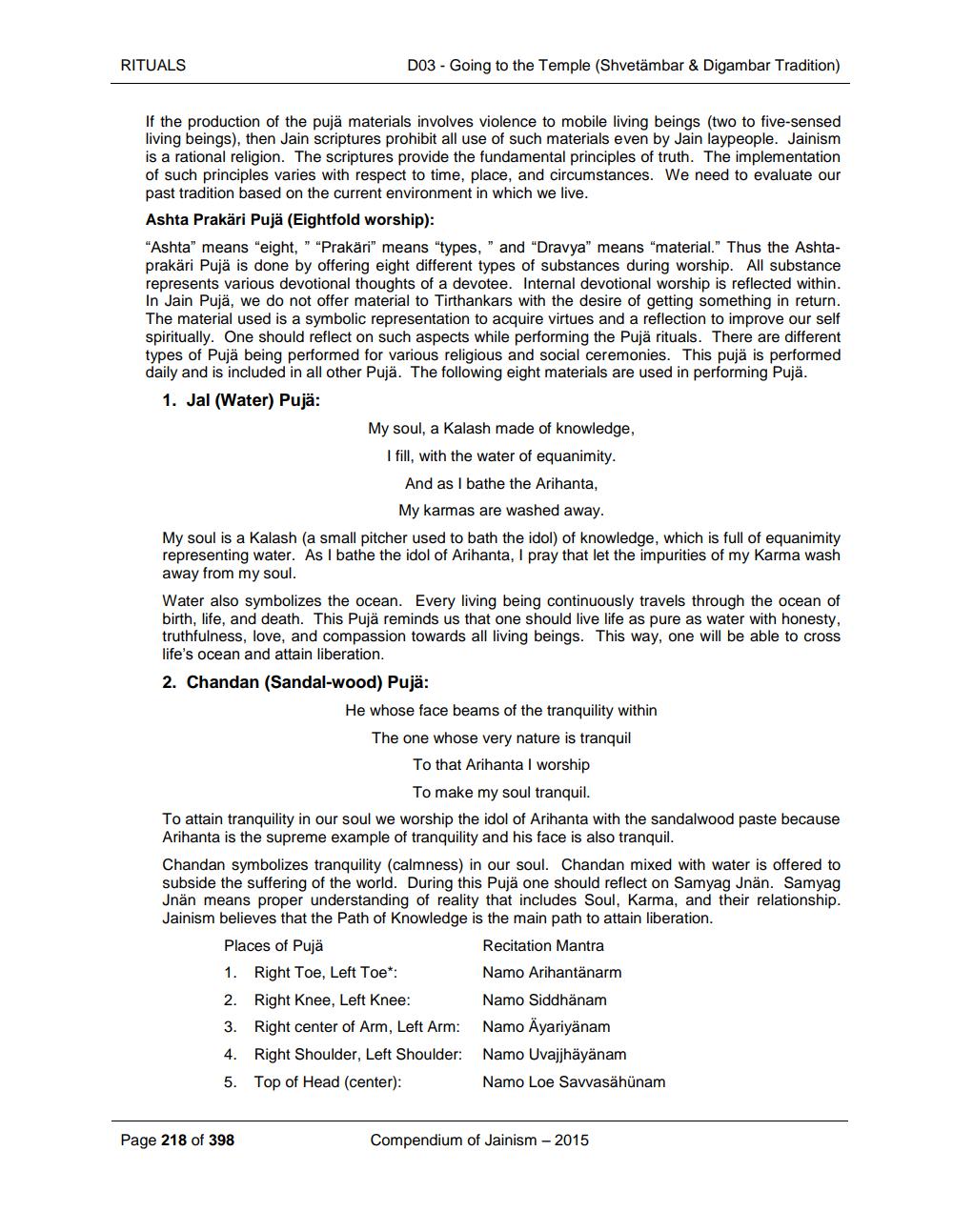________________
RITUALS
D03 - Going to the Temple (Shvetämbar & Digambar Tradition)
If the production of the pujä materials involves violence to mobile living beings (two to five-sensed living beings), then Jain scriptures prohibit all use of such materials even by Jain laypeople. Jainism is a rational religion. The scriptures provide the fundamental principles of truth. The implementation of such principles varies with respect to time, place, and circumstances. We need to evaluate our past tradition based on the current environment in which we live.
Ashta Prakäri Pujä (Eightfold worship):
"Ashta" means "eight," "Prakäri" means "types," and "Dravya" means "material." Thus the Ashtaprakäri Pujä is done by offering eight different types of substances during worship. All substance represents various devotional thoughts of a devotee. Internal devotional worship is reflected within. In Jain Pujä, we do not offer material to Tirthankars with the desire of getting something in return. The material used is a symbolic representation to acquire virtues and a reflection to improve our self spiritually. One should reflect on such aspects while performing the Pujä rituals. There are different types of Pujä being performed for various religious and social ceremonies. This pujä is performed daily and is included in all other Pujä. The following eight materials are used in performing Pujä.
1. Jal (Water) Pujä:
My soul, a Kalash made of knowledge, I fill, with the water of equanimity.
And as I bathe the Arihanta,
My karmas are washed away.
My soul is a Kalash (a small pitcher used to bath the idol) of knowledge, which is full of equanimity representing water. As I bathe the idol of Arihanta, I pray that let the impurities of my Karma wash away from my soul.
Water also symbolizes the ocean. Every living being continuously travels through the ocean of birth, life, and death. This Pujä reminds us that one should live life as pure as water with honesty, truthfulness, love, and compassion towards all living beings. This way, one will be able to cross life's ocean and attain liberation.
2. Chandan (Sandal-wood) Puja:
He whose face beams of the tranquility within The one whose very nature is tranquil
To that Arihanta I worship
To make my soul tranquil.
To attain tranquility in our soul we worship the idol of Arihanta with the sandalwood paste because Arihanta is the supreme example of tranquility and his face is also tranquil.
Page 218 of 398
Chandan symbolizes tranquility (calmness) in our soul. Chandan mixed with water is offered to subside the suffering of the world. During this Pujä one should reflect on Samyag Jnän. Samyag Jnän means proper understanding of reality that includes Soul, Karma, and their relationship. Jainism believes that the Path of Knowledge is the main path to attain liberation.
Recitation Mantra Namo Arihantänarm
Namo Siddhänam
Namo Äyariyänam
Namo Uvajjhäyänam
Namo Loe Savvasähünam
Places of Pujä
1. Right Toe, Left Toe*:
2. Right Knee, Left Knee:
3. Right center of Arm, Left Arm:
4. Right Shoulder, Left Shoulder: 5. Top of Head (center):
Compendium of Jainism - 2015




